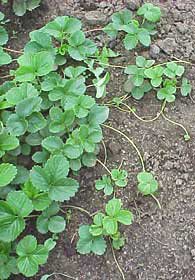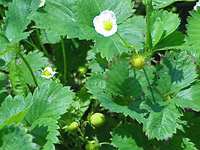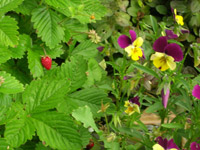Strawberries are one of the first fruits to mature in spring and one of the easiest to grow. While most varieties produce the second year after planting, day neutral varieties will produce a fall crop from a spring planting. Strawberry plants are small enough to fit in their own bed or among other flowers and vegetables. Once established and properly maintained, a strawberry patch can produce fruits for years.
Not only do strawberries taste great, they're good for you as well. Strawberries have higher levels of vitamin C, folate, and potassium than most other fruits, including oranges. The Nutrition and Health Research Center has shown that eating one serving (about 8 to 10 strawberries) a day can significantly decrease blood pressure, which may reduce the risk of heart disease. Other studies have found that strawberries can reduce risk of cancer and rheumatoid arthritis and enhance memory function. Plus, who can resist a strawberry shortcake, pie, or cobbler in early summer? So dig in and grow a patch of berries this summer.

The first fruit to ripen on the truss of berries is called the "king" berry and is the largest.
There are three different types of strawberries you can grow. June-bearing varieties produce berries for about 2 to 3 weeks in early summer. If you're looking to freeze or process your berries, grow some June-bearers. When selecting June-bearing varieties, choose an assortment that fruit early, mid, and late in the season to extend the harvest. They grow best in their own bed where they can spread.
Day neutral varieties produce a main crop in early summer and then smaller crops all summer long. They produce fruit more consistently than the older everbearing varieties. Alpine strawberry plants are smaller and produce tiny, intensely flavored fruits all summer. Day-neutral and alpine strawberries are perfect for producing a handful of berries each week to add to cereals and salads. They usually don't produce runners so are great planted in containers, small spaces, and in between other herbs, vegetables, and flowers in the garden.

June-bearing strawberries send out runners in summer that should be trained to root in rows at the appropriate spacing.
Here are some strawberry varieties to grow in your yard this spring. All are June-bearing varieties unless otherwise noted.

Strawberry flowers are frost sensitive. To protect them in spring cover the strawberry patch at night with a floating row cover. Remove the cover in morning so bees can pollinate the flowers.
Strawberries grow best on sandy loam soil in full sun. Strawberries don't like wet soils so choose a well drained site or create a raised bed at least 6 to 8 inches high. Don't grow strawberries where other strawberry-family crops, such as tomatoes, peppers, and potatoes, have been grown in the last 3 years.
PlantingIdeally, plant a cover crop of oat, wheat, or ryegrass the summer before planting. These cover crops add organic matter and fertility to the soil and help with weed control. Rototill the cover crop in spring at least one month before planting. Amend the soil with 2 pounds of a 5-5-5 organic fertilizer per 100 square foot row. Work the fertilizer into the top 6 inches of the raised beds.
In spring before planting, choose your growing system. The most common system for June-bearing varieties is the matted row. Space raised beds 4 feet apart. Soak the transplant's roots in warm water a few hours before planting. Plant strawberries 18 inches apart in double rows as soon as the ground can be worked. Set individual plants in the soil so the crown (fleshy area where the leaves emerge) is at the soil level. Planting too deep or too shallow can kill the transplant. Set alpine and day neutral plants one foot apart in rows. Plant closer if growing in containers or on terraced beds.
CareIn their first season let the runners of June bearing varieties fill in the spaces between plants but keep the two rows intact. Remove any flowers that form so plants direct their energy to getting established.
For alpine and day neutral varieties, remove any runners that form. This will force the mother plant to create multiple crowns and more fruit. Fruits will form later in summer the first year.
Keep well watered and weeded all summer.
In cold areas, mulch strawberry beds with a 3- to 4-inch-thick layer of straw mulch in late fall. In spring, check plants frequently and when the strawberry leaves start to show yellow, gently rake the straw off beds and use it to mulch around plants and between rows. The mulch preserves soil moisture, prevents weed growth, and keeps the berries from touching the ground and rotting. Protect the sensitive spring flowers from frost by laying a floating row cover over the plants if cold weather threatens.

Alpine strawberries grow well in a low, mixed flower garden with other edibles such as violas.
After harvesting June-bearing fruits, renovate the bed. Mow the strawberry plants to within 1 inch of the crowns. Rake and remove the cut foliage. Fertilize with 2 pounds of 5-5-5 organic fertilizer per 100 square feet. Water and weed well. Thin plants so the rows are 8 inches wide and plants 4 to 6 inches apart. With proper fertilization and renovation, your strawberry bed should be productive for 3 to 4 years. Day neutral crops should be fertilized, weeded, and watered well each spring and should last 2 to 3 years before needing to be replaced.
Strawberries are attacked by a variety of pests. To avoid verticillium wilt and red steel diseases, select disease-resistant varieties. Mulch the plants and clean up debris after fruiting and renovating to prevent mold from attacking the fruits.
A variety of insects attack strawberry roots, leaves, and fruits. Control root-feeding insects by growing a cover crop and rototilling the soil well before planting. Control leaf-eating insects, such as aphids, with organic sprays such as insecticidal soap. Prevent fruit damage by covering the beds with floating row cover after pollination by bees. Control snails and slugs by using a slug bait such as iron phosphate.
HarvestThe fruits of June-bearing plants will ripen about 1 month after the plants bloom in spring. The biggest berries, called "king" berries, develop at the center of each cluster. To harvest, don't squeeze a ripe berry; instead, pinch the stem behind it with your thumbnail. Every 2 or 3 days, pick all the ripe berries. Avoid picking green-tipped berries -- they're not fully ripe. They'll taste much better in a day or two.
More About StrawberriesSock it to Strawberry Diseases
Grow a Fall Crop of Strawberries
 Charlie Nardozzi is an award winning, nationally recognized garden writer, speaker, radio, and television personality. He has worked for more than 30 years bringing expert gardening information to home gardeners through radio, television, talks, tours, on-line, and the printed page. Charlie delights in making gardening information simple, easy, fun and accessible to everyone. He's the author of 6 books, has three radio shows in New England and a TV show. He leads Garden Tours around the world and consults with organizations and companies about gardening programs. See more about him at Gardening With Charlie.
Charlie Nardozzi is an award winning, nationally recognized garden writer, speaker, radio, and television personality. He has worked for more than 30 years bringing expert gardening information to home gardeners through radio, television, talks, tours, on-line, and the printed page. Charlie delights in making gardening information simple, easy, fun and accessible to everyone. He's the author of 6 books, has three radio shows in New England and a TV show. He leads Garden Tours around the world and consults with organizations and companies about gardening programs. See more about him at Gardening With Charlie.
 Victory Seed Company has all the seeds you want for your best garden in 2024.
Victory Seed Company has all the seeds you want for your best garden in 2024.
For 25 years, the family-owned Victory Seed Company has provided the highest quality vegetable, herb and flower seeds to families across the country. We are passionate about providing you the best seeds available that give excellent germination, robust plants, and the harvest you want. With a catalog of over a thousand varieties, we have everything, and our prices are the kinds that we'd want to pay. We have hundreds of yesterday's heirloom vegetables, as well as today's award winning hybrid selections. Get to know us by visiting our website and browsing through our online vegetable seed catalog.